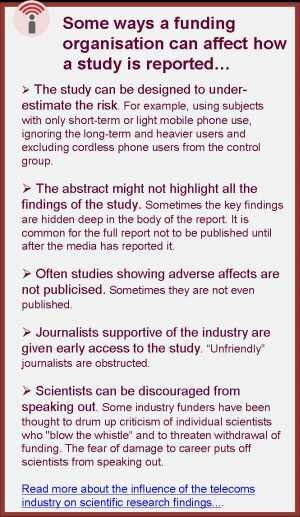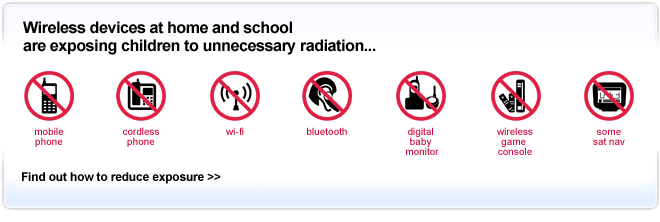Understanding the science
Is the jury still out on the health risks of mobile phones?
We sometimes hear in the press that the “jury is out” when it comes to the health risks of mobile phones. We hear one day about a study showing adverse health effects then another that a research has given them the all clear.
What are the public to do in the face of this uncertainty?
At WiredChild we wanted to investigate for ourselves. This is what we found:
1. All the independently-funded studies that included longer term users (10 years or more use) have shown an association between brain tumour incidence and mobile phone use.
In a number of studies the risks for some types of tumours is doubled or even quadrupled. The only studies that have not shown such a link were funded by the mobile phone industry or only analysed short-term duration of use. See the studies here...
Mobile phones have only been used widely since the late 1990’s so the early studies, mostly done in the early 2000's, didn’t involve long term phone users. They were done when it was too early for the association to show up. This has clouded the picture for the media and the public.
2. The studies generally under-estimate the risk
This is because:
|
|

{audio}http://electromagnetichealth.org/audio/Havas.mp3{/audio}
|
- they can only include people who are still alive (as they need to ask about mobile phone habits) so some of those who might have been worst affected are excluded
- many of the people in the control group and treated as un-exposed to the radiation being tested have been exposed through other sources. For example, many of the studies investigating the link between mobile phones and brain cancers have not extracted cordless phone users from the control group which means that the difference between the risks of those classed as users and non-users may be obscured.
- none of the studies into the link between mobile phone use and brain tumours has directly studied children
- The full extent of the risks of using a mobile phone will probably only show up when people have used them for 20 years or more
 3. Not all studies are independent. 3. Not all studies are independent.
Have a look at the list of brain tumour studies to see which ones are independently-funded. The independently-funded studies that included long-term mobile phone users found an association between mobile phone use and brain tumours, while mostly industry-linked studies found no association, normally having only studied short-term users. One study has demonstrated statistically that the funding source is linked to the results found...
When an industry wants to discourage concerns about safety, it can muddy the waters by funding research that shows no association, thereby leaving the press and the public confused and uncertain whether they need to act. Sometimes it is not obvious that they have funded the research. Read more...
The big corporates with significant financial interests in the mobile phone and wireless markets, have skilled PR and other staff able to work the system to the advantage of their corporate interest. Independent scientists and public interest groups, like us, rarely have the resources to counter this effect.
Some studies have small samples. While this reduces the weight they should be given, in our view a small independent study is sometimes more trustworthy than a larger industry-funded study.
There is now almost no independent funding of research into the effects of wireless technology in the UK. The industry-funded studies dominate in terms of number and consequently dominate the way the public health agencies assess the risk and the way the media reports the risk. Read more...
Sometimes, conflicts of interest are concealed...
4. Don’t rely on what you read in the papers.
Science is complex and studies are not always easy to interpret. Sometimes the media misunderstands.
Click here for an example of the media misunderstanding the science...
5. Don’t assume the government will warn you
The government has to strike a difficult balance between protecting public health and protecting the economy, so it doesn’t just have our children’s health at heart.
Businesses can put financial pressure on government and also have influence through their networking and lobbying arms. The mobile phone industry contributes about £15 billion a year to government finances. Coupled with expanding tax revenues from the fast-growing wireless industry, and further jackpots when licences are sold off (about £22 billion when they sold off the 3G licences in 2001) these discourage the government from alerting the public to the possibility of health risks.
Have a look at what happened in the early days of smoking research, and when the BSE scare was reported.
|
|
 …In the case of tobacco and lung cancer, debates over whether there was a true increase in lung cancer associated with smoking raged far longer than they should have, fomented by an active disinformation campaign... …In the case of tobacco and lung cancer, debates over whether there was a true increase in lung cancer associated with smoking raged far longer than they should have, fomented by an active disinformation campaign...
Recalling the 70 years that it took to remove lead from paint and gasoline and the 50 years that it took to convincingly establish the link between smoking and lung cancer, … we must learn from our past to do a better job of interpreting evidence of potential risks. 
|
|
 {audio}http://electromagnetichealth.org/audio/Carpenter.mp3{/audio} {audio}http://electromagnetichealth.org/audio/Carpenter.mp3{/audio}
|
|
|
|






 3. Not all studies are independent.
3. Not all studies are independent.
 …In the case of tobacco and lung cancer, debates over whether there was a true increase in lung cancer associated with smoking raged far longer than they should have, fomented by an active disinformation campaign...
…In the case of tobacco and lung cancer, debates over whether there was a true increase in lung cancer associated with smoking raged far longer than they should have, fomented by an active disinformation campaign...
 {audio}http://electromagnetichealth.org/audio/Carpenter.mp3{/audio}
{audio}http://electromagnetichealth.org/audio/Carpenter.mp3{/audio}